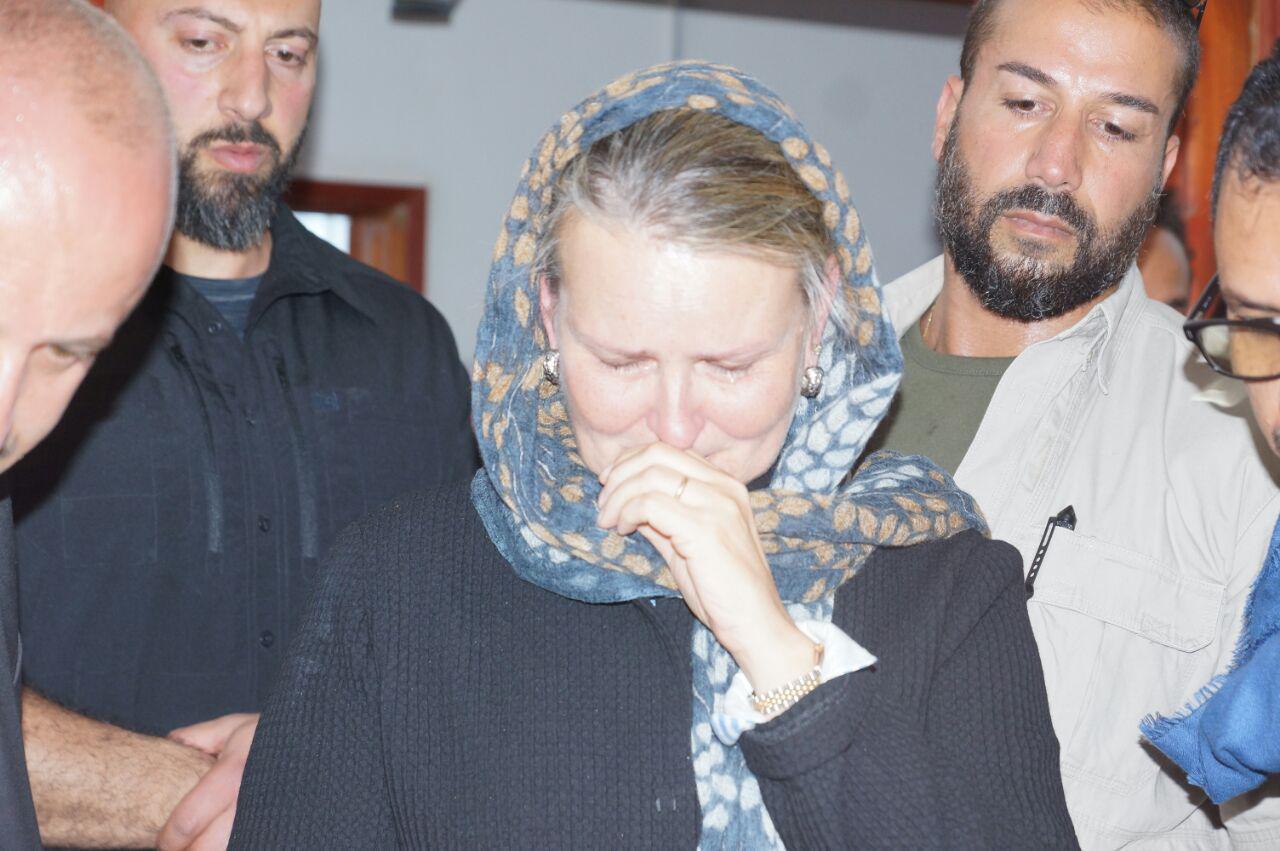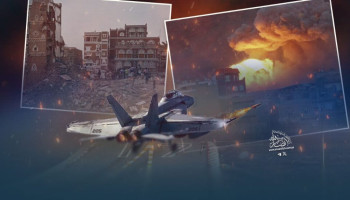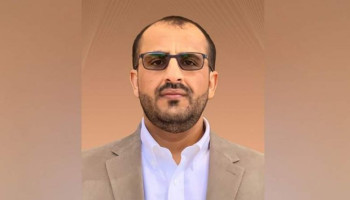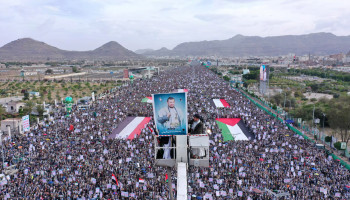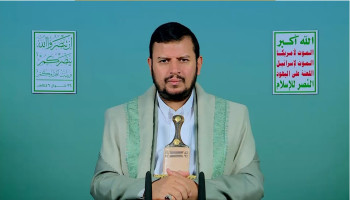They issued, based on them, condemnation statements regarding those crimes, in which all the most dangerous international criminal crimes agreed on international peace and security. They are crimes against humanity and crimes of genocide, aggression and war.
The data confirmed that the aggression country coalition killed thousands of innocent civilians, and also injured tens of thousands of civilians with severe injuries severe disabilities, and destroyed the foundations of life and the infrastructure of the Yemeni people, including civil installations, government interests, cultural properties, civilizational heritage, and human heritage. It also used internationally prohibited weapons in its air and missile strikes on residential buildings and civilian commercial and industrial facilities, and imposed an unjust siege and starvation against the Yemeni people. In addition, it killed children and women, targeted funeral parlors, wedding halls, schools and hospitals, committed more than a thousand war crimes, and caused displacement and displacement of the mass of tens of thousands of residents of the most affected areas as a result of the brutal devastating and comprehensive aerial bombardment. Furthermore, it caused the death of thousands of children, women and patients from the Yemeni people and the spread of epidemics and deadly diseases because of bombing with internationally prohibited weapons.
The data considered that those crimes committed are international crimes according to the humanitarian international law, the Charter of the United Nations and the relevant international agreements, and resulted in the international criminal responsibility of their perpetrators. The United Nations - especially the UN Security Council - is considered an international and legal liability for all these crimes and serious violations of international law, and that responsibility stems from The Charter of the United Nations and international conventions and treaties defining the tasks and obligations of the United Nations in maintaining international peace and security; Due to its failure to fulfill its international role and its complicity with the aggression country coalition that committed - and still is until now - the most heinous international criminal crimes against the Yemeni people while the United Nations doesn't perform its international duty to stop the aggression, take any deterrent measures, or protect the lives of the Yemeni people from the crimes of the unjust aggression coalition.
It is no longer a secret for anyone that the United Nations has sided with the oil and money of the Gulf, making it give up its humanitarian duty and pass on thousands of corpses and thousands of crimes.
Even when the United Nations tried to blacklist the aggression countries; Saudi Arabia threatened to stop the support, so it cancelled its decision in exchange for that money publicly without fear for its reputation, nor ashamed of all human beings.

Organizations breaks the silence
Despite the international silence towards these crimes by the United Nations, especially the UN Security Council, some international humanitarian and human rights organizations - such as Human Rights Watch, Amnesty International, the World Health Organization, the International Committee of the Red Cross, Oxfam, and Avaz - have issued reports. They explicitly included monitoring, documenting and condemning some of those crimes committed by the aggression coalition against the Yemeni people, holding the international community responsible for these crimes, and demanding that the perpetrators must be prosecuted, the aggressive war against Yemen must be quickly stopped, and the siege must be lifted.
Those organizations declared that Yemen is a country plagued by the aggression crimes, and those convictions issued by the organizations are considered in accordance with international charters and agreements, international humanitarian law and the United Nations Charter as international reports that have authority in international criminal evidence. They are also reliable on for international decision-making by the Security Council and other United Nations systems.

The crime of targeting the Great Hall
In this report, we review a set of condemnations that confirm the aggression’s commission of heinous crimes against the people of Yemen, beginning with Human Rights Watch, which said in one of its statements that the raid launched by the Saudi-led coalition on a funeral ceremony in the Yemeni capital, Sanaa, on October 8, 2016, appears to be a crime war. It noted that the attack resulted in the death of at least 100 people and the wounding of more than 500, including children.
Human Rights Watch said: The raid on the funerals underscores the urgent need for credible international investigations into alleged laws-of-war violations in Yemen. The United States, the United Kingdom, and other governments should stop arms sales to Saudi Arabia and the coalition should immediately allow commercial flights to Sanaa, which were suspended since August 2016, to allow every sick or wounded person to receive treatment abroad.
“After unlawful raids on schools, markets, hospitals, weddings and homes, the Saudi-led coalition has added a funeral ceremony to its growing list of violations, calling for an independent international investigation into this heinous crime, confirmed in time,” said Sarah Leah Whitson, Middle East director at Human Rights Watch, confirming that at the same that the coalition showed its unwillingness to conduct a credible investigation.
Human Rights watch interviewed by phone 14 witnesses to the attack and 2 men who arrived at the scene immediately after the airstrike to assist in the rescue effort, along with other sources. It also reviewed videos and photos of the strike site, and munitions remnants.

On October 8, hundreds of people gathered in the Great Hall, which had a capacity of 1,000 people, to attend the funeral of Ali al-Ruwaishan, the father of the Minister of Interior in the government in power in Sanaa, Jalal al-Ruwaishan. All the witnesses who spoke to Human Rights Watch said that at around 3:30 p.m., two airdropped munitions penetrated the ceiling of the hall and detonated a few minutes apart.
Shortly after the attack, MSF reported that six of its hospitals had treated more than 400 wounded.
One of the witnesses said: “When I arrived, there were more than 50 burnt bodies whose features could be recognized, but with half of the body and half of the head vanishing, but it was very difficult to know who the rest were.”
According to the Office of the High Commissioner for Human Rights at the United Nations, hundreds of those killed and injured were civilians, and one witness said he personally knew more than 45 civilians who were killed in the attack. Civilian lives or damage to civilian buildings exceeds the concrete and direct military advantage anticipated from the attack.
Returning to Human Rights, it said: The date and venue of the funeral ceremony were announced on Jalal Al-Ruwaishan's Facebook page on October 7, and it was reported that it is open to the public. It pointed out that the afternoon period, the hour of the attack, is a “peak time” in the funeral ceremonies that were open to the public, which means great crowding.
Human Rights Watch identified the munitions used as a US-made GBU-12 Paveway II (GBU-12 Paveway II) 225-kilogram laser-guided bomb.
In an attempt to manipulate the crime, the Human Rights Council issued a decision to organize two complementary investigations by the Human Rights Commission, with the assistance of additional experts in human rights, or from the committee appointed by the runaway, Hadi.
Human Rights Watch said that the coalition-backed committee that reports to Abd Rabbu Mansour Hadi did not have access to all parts of the country, and confirmed its lack of integrity, independence, and effectiveness, especially after the issuance of its first report.
The organization added that the United States became a party to the conflict during the first months of the fighting, while providing specific information about targets and providing fuel by air during bombing raids.
Immediately after the mourning raid, then-US National Security Council spokesperson Ned Price said the United States was "deeply disturbed" by the incident.
The United States has initiated "an immediate review of our support, which has already been significantly curtailed to the Saudi-led coalition," Price announced.
Human Rights Watch said that the US's careful review of its support for the coalition is a forward step, but does not absolve it of potential responsibility for any coalition military operations that US forces participated in and resulted in war crimes.

The raids on Mocha
Early on July 25, 2016, a news tape on Al Arabiya, a Saudi media outlet, reported that the coalition forces had raided an air defense base in Mocha.
It is clear that the air strikes carried out by the Saudi-led coalition forces on the Yemeni city of Al-Mokha resulted in the death of at least 65 civilians, including 10 children, and wounding dozens of others, whereas the international organizations said it is a war crime. At 9:30 PM and 10:00 PM, the coalition jets bombed two residential compounds in a power station in Mokha where the factory workers and their families live.
“The Saudi-led coalition forces have repeatedly bombed dwellings belonging to the power plant, killing dozens of civilians,” said Ole Solvang, a senior researcher in the emergency department.
In the absence of any evidence of a clear military objective there, this attack appears to be a war crime.
For its part, Human Rights Watch visited the site of the raid a day and a half after it happened and said that the excavation and damage to the buildings showed that the main residential complex, which houses at least 200 families, was targeted with six bombs. In addition, a bomb was dropped on another residential complex about one kilometer away, north the main compound, which is inhabited by temporary workers, destroying the water tanks. Two more bombs fell on the beach and a nearby intersection, directly hitting two residential apartments, causing parts of their roofs to collapse.
Other bombs exploded in areas between the buildings, such as the main square, destroying the outer walls of dozens of apartments, leaving only the building columns in place.
Some workers and residents of the housing complexes told Human Rights Watch that one or more aircraft dropped nine bombs in repeated sorties after periods of time that did not exceed a few minutes, noting that all the bombs targeted the residential compounds and not any other target.
Human Rights Watch acknowledged that there was no evidence that the two residential compounds of the power plant were being used for military purposes.
Human Rights Watch visited three hospitals in Hodeidah that had received 42 wounded patients because of the strikes, many of them in critical condition, including an 11-year-old girl.

Targeting a market in Hajjah
On March 15, 2016, the warplanes of the US-Saudi aggression launched two raids on a crowded market in Mustaba district of Hajjah governorate.
Human Rights Watch said that the airstrikes carried out by the Saudi-led coalition with bombs supplied by the United States killed at least 97 civilians, including 25 children, northwestern Yemen.
Human Rights Watch conducted field investigations on March 28 and found remnants of a GBU-31 satellite-guided bomb in the market, which consisted of a US 2-ton MK-84 bomb and a satellite-guided array.) In addition, Joint Direct Attack Munitions (JDAM) (provided by the United States.
A team of British ITV news channel journalists visited the site on March 26 and found remnants of an MK-84 bomb with Paveway laser guidance devices.
“Weapons supplied by the United States have been used in one of the deadliest attacks against civilians in the Yemen war ", Priyankamutaparthy, emergencies researcher at Human Rights Watch said.
https://www.ansarollah.com.ye/wp-content/uploads/2020/04/%D8%B4%D8%A7%D9%87%D8%AF_%D8%A7%D9%84%D9%85%D8%A3%D8%B3%D8%A7%D8%A9_%D8%A7%D9%84%D8%A3%D8%B4%D8%AF_%D9%81%D9%8A_%D9%85%D8%AC%D8%B2%D8%B1%D8%A9_%D8%B7%D9%84%D8%A7%D8%A8_%D8%B6%D8%AD%D9%8A%D8%A7%D9%86_%D8%A7%D9%84%D8%B4%D9%87%D9%8A%D8%AF_%D8%A7%D9%84%D9%85%D9%81%D9%82%D9%88%D8%AF_%D8%A7%D9%84%D8%B7%D9%81%D9%84_%D9%85%D8%AD%D9%85%D8%AF.mp4?_=1
Dhahyan children massacre
In August , 2018, most international organizations denounced strongly what the American-Saudi aggression carried out , targeting a bus carrying students in the middle of Dhahyan market in Saada governorate, which resulted in 50 dead and more than 70 wounded, most of them children.
United Nations Secretary-General Antonio Guterres condemned the massacre and called for an independent and immediate investigation.
Spokesman for the Secretary-General, Farhan Haq, said that Guterres called for an independent and immediate investigation into the Saudi raid.
UNICEF Motherhood and Childhood Organization at the United Nations described it as horrific and said it represented a low point in the brutal war on Yemen.
The Executive Director of the organization, Henrietta Fore, demanded in a statement issued in English that this unjustified attack on children must be a turning point in Yemen's brutal war.
She added: The horrific attack on a bus in Saada, Yemen, in which large numbers of children were killed and maimed, represents a low point in the country's brutal war, and demanded the Save the Children International organization with an investigation.
The High Commissioner for Human Rights has expressed deep concern about the high number of civilian victims in Yemen and called for a comprehensive investigation, saying The UN Human Rights Council should adopt a resolution establishing an international fact-finding committee to investigate allegations of violations of international humanitarian law in Yemen since the beginning of the war.
“Again and again, we see coalition airstrikes killing large numbers of civilians,” said Ole Solvang “but there is no sign of investigations that. He added if coalition members do not initiate investigations, the United Nations should do so on its own.”
[caption id="attachment_197316" align="alignnone" width="300"]
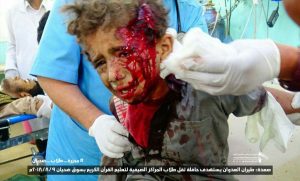 ارشيف[/caption]
ارشيف[/caption]
Documenting various crimes
Many organizations have documented dozens of unlawful raids that have caused civilian losses in lives and property, and other human rights organizations and the United Nations have documented dozens of others.
According to the Office of the High Commissioner for Human Rights, 4,125 civilians were killed and 7,207 injured in Yemen between March 2015 and October 2016, most of them in coalition airstrikes.
The commission stated that the air strikes were "the single biggest cause of casualties" over the past year.
Human Rights Watch said that Saudi Arabia should not have a place in the UN Human Rights Council, especially after it had previously used its position to obstruct efforts to conduct an international investigation into the ongoing violations in Yemen.
Several organizations had investigated a number of air strikes that appeared to be unlawful, and concluded that, on March 31, 2017, for example, warplanes dropped bombs on a factory in Hodeidah, killing at least 31 civilians.
Human Rights Watch documented the air strikes on a market in the city of Zabid on the western coast, which killed at least 60 civilians on May 12, 2015, and on July 4, a raid in a market in the town of Muthalath Aahim, which is 20 kilometers northwest of Mustaba, killed at least 65 civilians, and coalition forces bombed at least 5 major markets in the northern city of Saada.
Since March 26, 2015, the United Nations and non-governmental organizations have documented numerous coalition airstrikes that violated the laws of war, in the report of the United Nations Group of Experts on Yemen, established under Security Council Resolution 2140), documented hundreds of coalition air strikes that violates the “laws of war”.
During the first two years of the aggression, Human Rights Watch documented 36 unlawful airstrikes, some of which may amount to war crimes. It also documented attacks in which internationally banned cluster bombs were used in or near cities and villages, which resulted in the injury or killing of civilians. Cluster munitions were used in several Locations in at least five of the 21 Yemeni governorates, namely Amran, Hajjah, Hodeidah, Saada, and Sana'a, coalition forces used at least 6 types of cluster munitions dropped from aircraft.
On the ground, researchers' investigations have documented the use of unguided aircraft bombs, guided bombs such as the "Paveway" series laser guided, JDAM satellite-guided bombs including "109-BLU bunker-busting" bombs and a variety of cluster munitions.
These weapons were produced and exported by the United States and a number of European countries such as France, Italy, Spain and the United Kingdom. In addition to these munitions, these same countries have sold attack aircraft such as ground-attack launchers and helicopters that deliver these weapons to Saudi Arabia.
The United Nations Group of Experts concluded that the coalition's targeting of civilians through air strikes - whether by bombing residential neighborhoods or by treating the cities of Saada and Maran in northern Yemen as military targets - is a serious violation of the principles of distinction, proportionality and prevention. The team also concluded, in some cases, that these violations were widespread and systematic. Deliberate, indiscriminate, and disproportionate attacks against civilians are serious violations of the laws of war, which are binding on all warring parties.
The Group of Experts said that the attacks it documented included attacks on camps for internally displaced persons and refugees, civilian gatherings, such as weddings, and civilian vehicles such as buses.
The attacks also targeted, according to the team, civilian residential areas, medical facilities, schools, mosques, markets, factories, and food storage warehouses.
The targets also included other basic infrastructure, such as Sanaa airport, Hodeidah port, and local transit routes.
Conclusion
In general, the coalition air strikes throughout Yemen, in clear violation of international humanitarian law, resulted in the death of thousands of civilians.
The thousands of strikes launched on populated sites, hospitals, schools, markets and mosques represent war crimes, and the UN Committee of Experts has documented 119 coalition raids that were associated with violations of international humanitarian law during the first two years.
It is clear that the coalition has excessively used internationally banned cluster munitions, causing civilian casualties and posing an immediate and long-term threat to civilians, in the form of unexploded ordnance. The maritime embargo imposed by the coalition on Yemen has contributed to a stifling humanitarian crisis that has left 80% of the population of this poor country in need of protection and humanitarian assistance.
Consequently, the suspicious silence that human rights and humanitarian organizations follow with every massacre the Yemenis are exposed to, and with every war crime committed against women and children, reinforces the certainty of everyone that international silence is the real killer of the Yemeni people.
In addition to the persistence of the aggression coalition in committing mass massacres of civilians, it would have been nothing but a result of its confidence in the complicity of international organizations and their paid-for-price disregard for all the daily war crimes that the aggression boasts of committing in front of the world.


